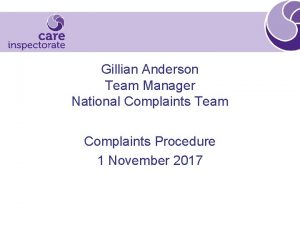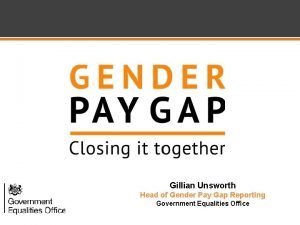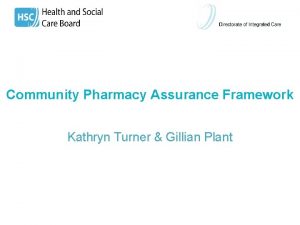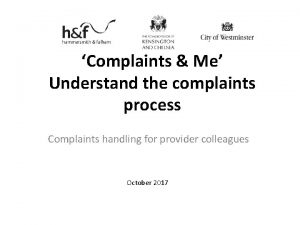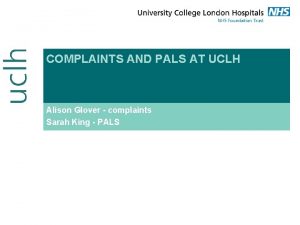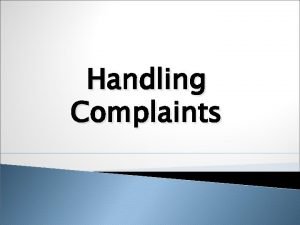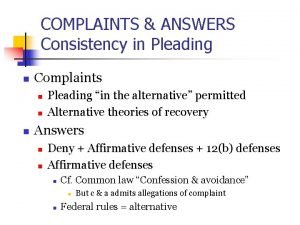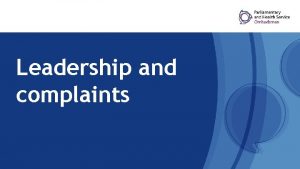Gillian Anderson Team Manager National Complaints Team Complaints













- Slides: 13

Gillian Anderson Team Manager National Complaints Team Complaints Procedure 1 November 2017

Why Change? • In 2015/16 we received 4, 086 complaints about care services. This is an increase of 46% over the five year period, and means we are dealing with over 100 more complaints per month than we were in 2011/12. • Ensure we use our resources appropriately. • Move away from one size fits all approach; prioritise complaints that place people at risk. • Feedback from consultation with stakeholders § Focus on outcomes and improvement § Right of response

What People Told Us Consultation: Survey 2015, complaint research & 12 public sessions in 2017. • • • Need to have different options for resolving issues Not everyone wanted a full investigation Help to get service to listen and respond to issues Want improvement in services Concern over time taken to complete complaint investigation

Key Changes • Definition of a complaint • Triage Complaints: Risk Assessment • Triage Responses: front line resolution, provider resolution and complaint investigation by Care Inspectorate. • Care Inspectorate’s decision how to manage complaints - no right of appeal • Post Investigation Review

Key Changes Definition Current definition A complaint is an expression of dissatisfaction about a registered care service's action or lack of action, or about the standard of service provided by, or on behalf of a service. New Definition 'an expression of dissatisfaction by a person receiving care or support from a registered care service or from one or more members of the public about the care and/or support of an individual or individuals by a registered care service. ’

Key Changes Risk Assessment • • • Identifying priorities Target resources Transparency of decision making Record decisions Framework for consistency

Assessing the seriousness of a complaint High Serious complaints about failings in care that have led to, or are highly likely to result in poor health and wellbeing outcomes for an individual or individuals i. e. illness or injury Medium Organisational issues that have the potential to present a risk to service users, e. g. staffing levels, recruitment /training, environmental issues, missed and late visits Low Complaints that do not relate to the provision of care and/or lack sufficient detail to identify or assess risk.

Key Changes Risk Assessment Risk Matrix

Risk Assessment Consider the source Reliable A known source that is impartial and credible, for example, Police, Social Work, Health Services. Likely to be reliable An identified source that is able to provide detailed account of events and identify possible sources of corroboration. Untested An unidentified source providing vague information and no sources of corroboration. The reliability of the source cannot be judged

Our Response

Key Changes Post Investigation Review • Replaces current review and error response. • Gives the provider the same right of review as the complainant. • Transparent, accountable, consistent, proportionate and targeted.

Main Changes of Review Process • Replaces current review and error response. • The complainant and the complained against will have the same right of review • Reviews will be undertaken by the complaint inspector • Where changes are not agreed these will be discussed with senior inspector or team manager • Transparent, accountable, consistent, proportionate and targeted.

Thank you any questions?
 Gillian anderson manager
Gillian anderson manager Senior manager vs general manager
Senior manager vs general manager Portfolio manager synergy manager parental developer
Portfolio manager synergy manager parental developer Gillian hazell speech language therapist
Gillian hazell speech language therapist Gillian roehrig
Gillian roehrig Gillian unsworth
Gillian unsworth Gillian plant
Gillian plant Dr gillian jessurun
Dr gillian jessurun Gillian dyer
Gillian dyer St david's day poem
St david's day poem Gillian dennehy
Gillian dennehy Gillian dell
Gillian dell Esli osmanlliu
Esli osmanlliu Gillian hamilton
Gillian hamilton
